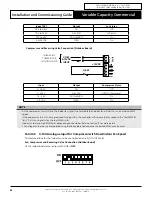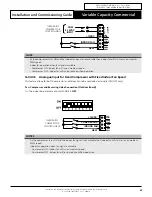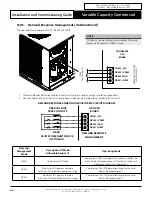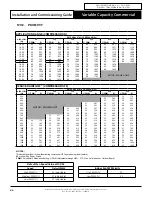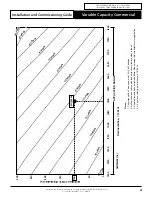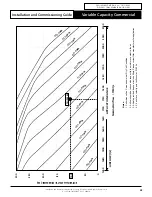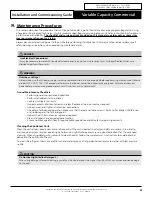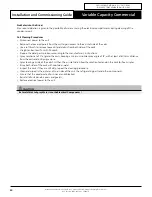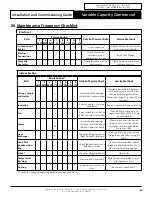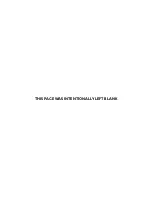
Installation and Commissioning Guide
Variable Capacity Commercial
PRELIMINARY DATA ONLY Ver. 5.01 210406
THIS LABEL TO BE REMOVED ON SIGN-OFF
51
Installation and Commissioning Guide- Package Ducted Variable Capacity Commercial
Doc. Part No. 0525-067 Ver. 5 210414
NOTES
• Accurate pressure and temperature measuring tools should be used to achieve satisfactory results.
• The sensor of a thermocouple must be in good contact with the area being measured and must be insulated in order to
obtain correct reading.
Checking for Subcooling:
1. From the R-410A Pressure/Temperature Chart record the corresponding Saturated Condensing Temperature
(SCT)
at
the given discharge pressure.
2. Calculate the system subcooling using the formula below:
Subcooling = SCT - LLT
3. If subcooling is within the range (see charging table below), there is no need to add/remove refrigerant.
• If subcooling is lower than minimum, the system is undercharged, it is necessary to add refrigerant.
• If subcooling is higher than maximum, the system is over charged, It is necessary to remove the refrigerant.
Allow the systems to stabilise (15-30 mins) and repeat the step 1-3 until subcooling falls within the range specified in the table
below.
Checking for Superheat:
Maintaining the correct superheat is important for ensuring the evaporator is achieving maximum capacity and avoiding
excessive liquid refrigerant returning to the compressor.
1. From the R-410A Pressure/Temperature Chart record the corresponding Saturated Suction Temperature (
SST
) at the
given suction pressure.
2. Calculate the system superheat using the formula below:
Superheat = SLT -SST
3. If superheat is within the range (see charging table below), there is no need to add/remove refrigerant.
• If superheat is lower than minimum, it means that liquid refrigerant may be returning to compressor. It is necessary to
remove refrigerant or check EEV settings (EEV used in ESP models only).
• If superheat is higher than maximum, it means that refrigeration capability of evaporator is not fully maximised. It is
necessary to add refrigerant charge or check EEV settings (EEV used in ESP models only).
Allow the systems to stabilise (15-30 mins) and repeat the step 1-3 until superheat falls within the range specified in the table
below.
SUBCOOLING / SUPERHEAT
Models
COOLING
HEATING
Subcooling
Superheat
Subcooling
Superheat
PKV290T-T
7 ±1
3 ±1
12 ±1
2 ±1
PKV330T-T
8 ±1
4 ±1
13 ±1
6 ±1
PKV290T-L/R
8 ±1
4 ±1
14 ±1
2 ±1
PKV330T-L/R
9 ±1
7 ±1
14 ±1
1 ±1
NOTE
The above subcooling and superheat recommendations are based on the following rated conditions:
• Cooling: 35°C DB outdoor, air entering indoor at 27°C DB / 19°C WB.
• Heating: 7°C DB / 6°C WB outdoor, air entering indoor at 20°C DB Nominal indoor airflow.


